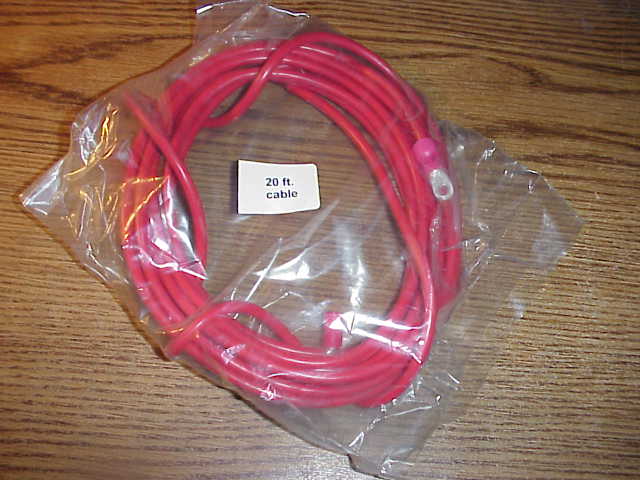The addition of the Sun Performance QuickAir2 on-board air in the TJ was a fairly simple project. I opted to make the QA2 compressor a permanent installation rather than getting the portable compressor setup. As usual, I ended up spending too much time trying to figure out where to install it. Once that was decided, the installation took just a couple of easy hours.
 |
After looking over the available space in the rear of the TJ, I decided to mount it just behind the right rear roll bar, where the bar attaches to the fender well. A better mounting spot would have been in front of the roll bar mounting point, but that space is occupied by my automatic antenna coupler for the Icom 706 radio. Given the close proximity of the hard top and the Jeep’s sheet metal, I was only able to use 3 of the 4 mounting holes. This seems to be of no major problem, as the three in use seem to hold everything in place quite well. I used 1/4″ bolts with nylocs to fasten the compressor in place (did not want any vibration to loosen up the mounts). | ||||||||||||||||||||||||||||||||||||||||||||||||||||||||||||||||||||||||||||||||||||||||||||||||||||||||||||||||||||||||||||||||||||||||||||
|
Quick Air2 flow rates —> |
Flow Rates: 2.18 cfm @ 0 psi @ 22 amps 1.76 cfm @ 20 psi @ 22 amps 1.45 cfm @ 40 psi @ 24 amps 1.20 cfm @ 60 psi @ 25 amps 0.99 cfm @ 80 psi @ 26 amps 0.85 cfm @ 100 psi @ 26 amps 0.77 cfm @ 105 psi @ 28 amps |
Duty cycle rating: 40 min. @ 40 psi 15 min. @ 80 psi 5 min. @ 105 psi |
|||||||||||||||||||||||||||||||||||||||||||||||||||||||||||||||||||||||||||||||||||||||||||||||||||||||||||||||||||||||||||||||||||||||||||
 |
Power for the compressor is obtained from a pair of #8 gauge wires that enter the rear end via a hole in the roll bar. I long ago removed the rear seat and the seat belts, and the seat belt mounting slot on the rollbar provides an entry spot for the wiring without the need to drill any additional holes. The wiring runs the length of the frame up to the engine compartment. I mounted the supplied 40 amp resetting breaker on the fender well, and attached the positive wire to it. The other post on the breaker is connected to the main feed point on the fuse panel where it receives the +12V from the Optima battery.The switch that came with the compressor was installed in the negative lead at the base of the compressor. Since I’ve never been fond of using the vehicle frame as a ground return for the negative battery connection, another #8 gauge was installed and connected in the engine compartment at the negative battery terminal. | ||||||||||||||||||||||||||||||||||||||||||||||||||||||||||||||||||||||||||||||||||||||||||||||||||||||||||||||||||||||||||||||||||||||||||||
| The local 4×4 store was out of the QuickAir air hose assembly, so I got one made for ARB. Since the quick disconnects are not of the same style, I swapped the male unit on the compressor so it would match the air hose (the air hose came with both the male and female connectors). Since I do not use an air tank, the air hose must be of the open flow design so it does not overload the compressor when you do not have it attached to the valve stem on a tire. When it is not connected, the compressor runs and the air exits at the “working” end of the hose.There is a warning label on the compressor that cautions you about the compressor getting hot…..it does! There is a duty cycle time limit for the compressor. At the pressure I run in my tires, it gives me about 40 minutes of run time. Depending on how low I drop my tire pressure, it takes between 1 and 3 minutes to inflate my 30×9.5 tire. It will take the tire from 18 to 40 psi in 2 minutes and from 25 to 35 psi in a minute flat. I checked my 32″x11.5″ BFG MTs the other day and QA2 took 2.5 minutes to raise the tire from 15 go 25 pounds. Unless you plan on airing up the entire group after the run, you should never come close to exceeding the run time limit of the compressor.
In summary, I really like my QA2 setup. It is easy to use, easy to get to, and gives me some piece of mind. As I write this, I have used it on my last two trips and found it to work very well. While the tires are airing up, it gives me time to dig through the cooler and find the last cold soda before hitting the highway and heading for home. I would recommend this compressor to anyone who wants off-road air capability. Late note: It has been several months since I wrote the above article. Since then, I have used it dozens of times and I still like it just as much, and maybe even a bit more. I had the pleasure of having a friend along a couple of trips back who had never aired down before. He dropped his tires to about 15 pounds and was very pleased with the result. I aired him up at the end of the day, and he too was impressed at how quickly his tires were back to street pressure (he was running P215s or something like that on a non-Jeep vehicle….argh!!!!) But none the less, he has been converted over to airing down to smooth out the ride and improve the traction on his vehicle. (Now, if I can convince him to get QuckAir2 so he’ll stop using mine!) February 2001: The QA2 has been chugging away for about 18 months now and has seen a LOT of use. It is pretty common for me to air up another vehicle at trail’s end, along with mine of course. I would calculate that I have about 3~4 years worth of “single Jeep” work out of it so far. Can’t complain about that. In another month or so, my 32″ BFG MTs will be replaced with 35″ MT/Rs. I know I won’t be getting the same air up times I have become use to thus far. I guess I am going to have to plan for a few more minutes in order to fill up void in these tires. February 28, 2001: I received e-mail from a gentleman named Eric Lund about a month ago. He wrote: Hi Stu, I came across your website today….Very cool. We are the manufacturers of your QuickAIR2 compressor. After reading your section about the compressor install, there is one thing that I would like to suggest. That would be to upgrade the power supply lead to #8AWG wire. It has been our experience that running any wire size smaller than that, especially when the unit is located far from the battery, may lead to premature failure of the unit. Send me your mailing address and I’ll send you our Part# WP208. (20 ft. #8AWG) Best Regards, Eric I answered his note and explained that I would be most happy to install the correct gauge wire (my QA2 was a demo unit and it did not come with all of the extras). Today, when I arrived home, there was a package sitting there waiting for me. I opened it and found the 20′ wiring harness that Eric had told me about. So, I have edited the section above to reflect that one should be using 8 gauge wire and I will be installing it on my Lady before my next wheelin’ weekend. I just wanted to take a moment here to thank Eric and Sun Performance. As far as I am concerned, Eric exceeded the customer service rating of A+. He had zero obligation to do what he did. I know now, more than ever before, that I made the right decision when I bought my QA2. The fact that I have a great pair rocker panels from them to is just extra icing on the cake. A big thanks to Eric and Sun Performance!
|
|||||||||||||||||||||||||||||||||||||||||||||||||||||||||||||||||||||||||||||||||||||||||||||||||||||||||||||||||||||||||||||||||||||||||||||
| June 3, 2001 – I got the flow rate and pressure specs from Sun Performance so the performance of their 3 Quick Air compressors could be easily compared.
|
|||||||||||||||||||||||||||||||||||||||||||||||||||||||||||||||||||||||||||||||||||||||||||||||||||||||||||||||||||||||||||||||||||||||||||||
QuickAir2 Installation
The addition of the ARB lockers to the front and rear axle resulted in my installing an ARB air compressor. To date (about 3 years as I write this), I have had zero problems with the ARB compressor and the air lines used to actuate the ARB lockers. However, I’ve always been one to stack the deck in my favor (when I can) when it comes to trail reliability. So, after helping MikeW with his ExtremeAire OBA installation, I decided I might was well upgrade my QuickAir2 setup so it could be used as an alternate ARB air source should the need arise. The expensive parts for such a backup (the compressor) was already in the Jeep. All I needed was some odds and ends to make it into a backup air source for the lockers. I didn’t want the project ballooning into an black hole where I could pour more money….I wanted to do this on a shoe string budget but still keep things safe and reliable.
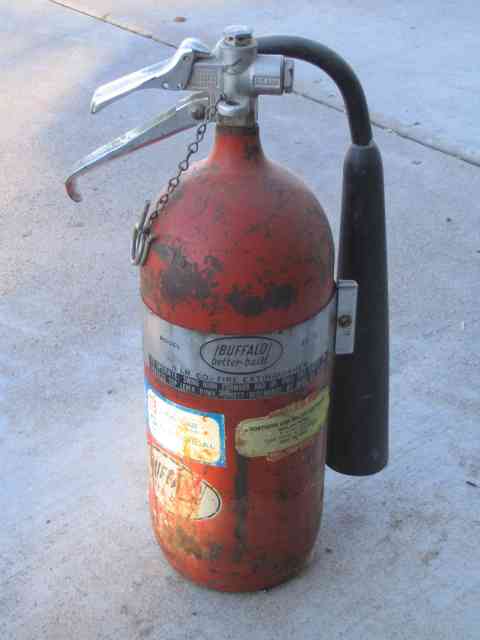
No, that is NOT an old 5# CO2 fire extinguisher…..it is an OBA tank, just waiting to be modified and put into use. The QuickAir2 has a very small air chamber on it and, in my opinion, it really does not lend itself to be setup with air solenoids and a pressure switch like the ARB compressor uses. I just couldn’t see myself attempting to make the QuickAir2 into a clone of the ARB. So, I decided that I would add a small air tank and mount a couple of the necessary components on it.
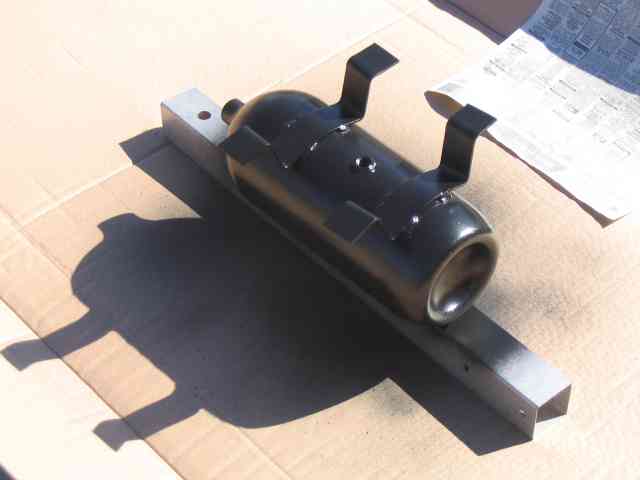
After the tank was disassembled, I drilled 3 holes in it (one on the bottom, two on the top) and got Troy, of Toys by Troy, to weld in some 1/4″ NPT bungs. I bent some 2″ wide strap into a couple of mounting brackets and had the brackets welded to the tank. After a session with the wire brush, a few coats of satin black rattle can paint got the tired old fire extinguisher looking pretty good.
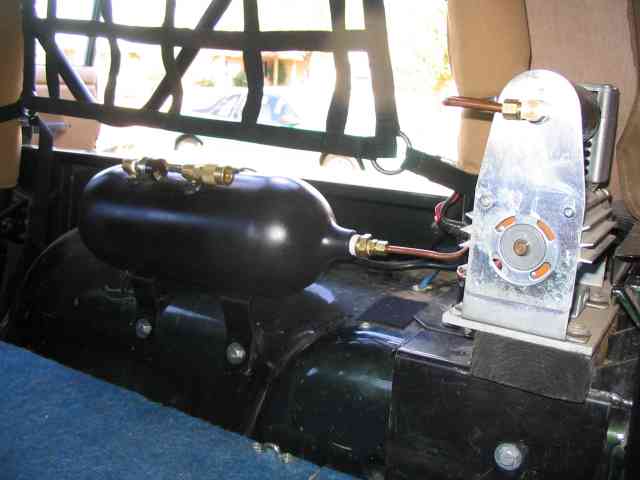
I stopped by MikeW’s place and we drilled some holes in the passenger side fender. A handful of 5/16″ bolts, Nyloc nuts, and some fender washers put the tank securely in place. Mike even had some under coating left over so he gave the mounting hardware a coat of it so it would blend in with the rest of the inner fender. (The plastic liners went away some time back about the time that the LED lights were installed.) I used 1/4″ soft copper tubing to connect the QuickAir2 to the newly installed air tank. 1/4″ compression fittings were used at each end of the tubing. A threaded reducer was used to on the extinguisher’s neck opening to size it for the 1/4″ tubing fitting. All of the fittings and tubing were obtained at the local ACE hardware store. Nothing fancy here….just plain old brass hardware fittings. The tank was fitted with a couple of 1/4″ 90 degree fittings to which a quick release air fitting and an ARB pressure switch was installed. Since I wanted this setup to properly actuate the ARB lockers, should the need arise, I opted to use my spare ARB pressure switch to keep the tank pressure within ARB limits. I was a little apprehensive about the QuickAir2 being able to generate enough pressure to actuate the pressure switch since both are rated at 105 PSI. As it was, the compressor was able to generate adequate pressure to turn itself off. I used a 40 amp relay to control the main power to the compressor. The ARB pressure switch is connected into the relay’s control line, along with a dash board power switch, to regulate tank pressure and control power to the compressor, respectively.
My ARB compressor is mounted in the engine compartment. The ARB air lines originate from the compressor’s air solenoids. In order to easily make the QuickAir2’s air tank a source for ARB air, it was necessary to remote the air solenoids (and thus the blue air lines) from the ARB compressor. This is done using an air manifold. An air line from the QuickAir2’s tank is routed to the engine compartment to provide the backup air for the lockers.
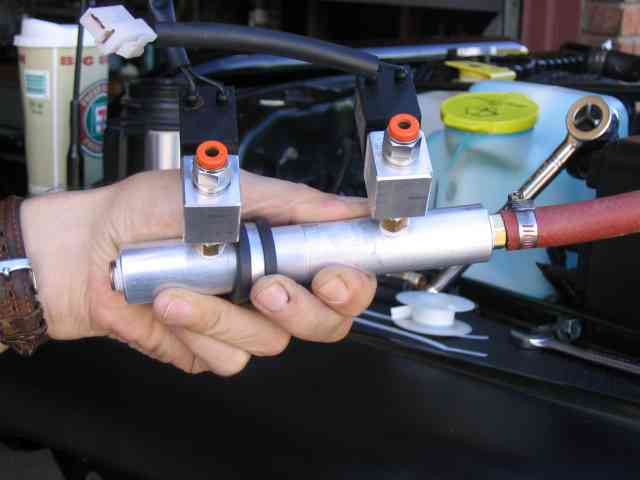
I got a friend of mine to make a couple of air manifolds from some aluminum round stock. The hole running the length of the aluminum was the size needed to tap the piece for a 1/4″ NPT fitting. After the center was bored to the correct size, I tapped it for 1/4″ NPT and then drilled a couple of ARB solenoid mounting holes and tapped them for 1/8″ NPT.
It should be noted here that the ARB solenoids do NOT use a common 1/8″ NPT fitting but rather a 1/8″ BSPT fitting. The major difference between the two is that one has a thread count of 27 TPI while the other is 28 TPI. Depending on who you talk to, some say you can put a regular 1/8″ NPT into the BSPT tapped hole and there won’t be any problems while others say it will leak. When MikeW was making his manifold, he opted to do it the conservative way and purchased a couple of 1/8″ NPT to 1/8″ BSPT fittings (male to male coupler) from McMaster-Carr’s on-line catalog, just to be safe. I had him pick me up a couple at the same time and used them on my manifold. The ARB solenoids that were in the ARB compressor were removed and used in this manifold. I used a conduit clamp (for holding conduit in place) on the manifold to secure it in the engine compartment.
I had a 25′ length of 3/8″ air hose, rated at 225 PSI working pressure, that I bought at a surplus sale. It was new and already had the necessary quick disconnect fittings on it. I cut 2′ of the end of the hose that had the male fitting on it. Using the 3/8″ hose barb that was screwed into one end of the manifold, I attached the 2′ length of hose to it.
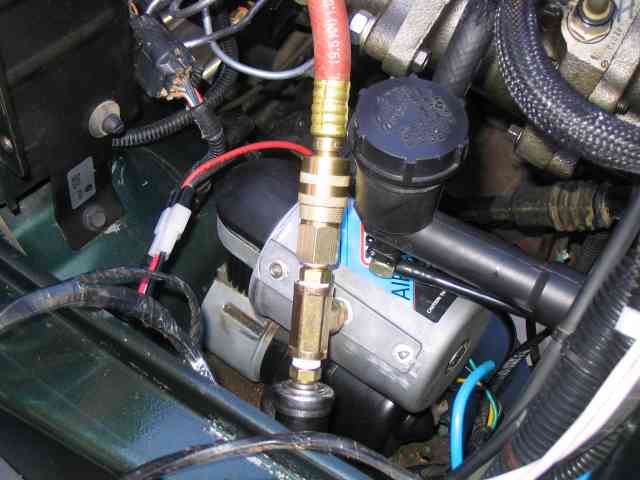
Meanwhile, back at the original ARB compressor, the solenoids were removed, cleaned, and reinstalled on the air manifold (the one with the 2′ length of hose attached to it). The pressure switch was removed from the compressor and a 1/4″ NPT t-fitting was screwed into its place. The pressure switch was attached to the new t-fitting along with a female air hose quick disconnect. The holes in the compressor where the air solenoids were located were plugged with the same plugs that came with the compressor. (I knew I kept those shiny little plugs for a reason).

Although not easy to see, the air manifold is shown in position, mounted at the edge of the tray that the ARB compressor is bolted to (with the 2 blue air lines going to it). The factory ARB wiring harness was sufficient to accommodate the relocation of the air solenoids on the newly installed manifold. You can see the red rubber hose going from the manifold to the ARB compressor. If needed, this same hose can be easily disconnected from the ARB compressor and attached to the air line that runs from the QuickAir2’s tank at the rear of the vehicle. The backup ARB air source is now fully functional and can be enabled in about the same amount of time it takes you to lift the hood on the TJ.
That is about it for this modification. It’s pretty simple to do and was easy enough on the budget too.
Good trails and TREADLightly!
QuickAir 3 Pics
Added: 06/02/2002
I was opening my e-mail and found a note from a Jeeper, John Nicewonger, who had contacted me earlier about my QuickAir 2 setup. John ended up doing a QuickAir 3 install on his TJ and was nice enough to send a couple of pics my way (using his new digital camera). I’ve included his comments from the e-mail. One thing for sure, John as used up most of the available space under the hood…..looks good!

John wrote:
The most important thing is the brackets. Once the factory Air Box is gone you actually get to use 2 of the existing factory holes, you drill ONE hole in the fender well and the final bolt only goes into the bracket (that’s the one nearest firewall and nearest engine). The bracket is held on with some pop rivets at the bottom using 3 small holes (drilled) in a V design. Notice that in the front of the Compressor there is no bracket at all, instead a piece of Nylon (forgot what that’s called) was used with a long bolt going right down through the foot of the compressor mounting and through the wheel well) I believe one could replace that particular piece (probably not available to most) with a very heavy duty piece of PVC 80 or whatever its called and use a washer and bolt. Or even two pieces of PVC one inserted in the other and glued then the bolt down through.
On another point, did you notice that PUMP in front of the QAIII? That’s the pump for my ON BOARD SHOWER. Really NICE for camping.

Added: 05/02/2004
I got an e-mail from another QA3 user today, Bill Echols. He belongs to the same 4×4 club as does John (above). Bill mentioned that he installed his QA3 in the rear of this vehicle (similar to the way I did my QA2) after he spoke with John and another club member who both have their QA3s under the hood. It seems the heat build up, after a day of wheelin’, causes some issues with the QA3. John did not go into detail but I would assume it is over heating. If so, that is NOT a good thing to have happen to these electric motors and pumps.
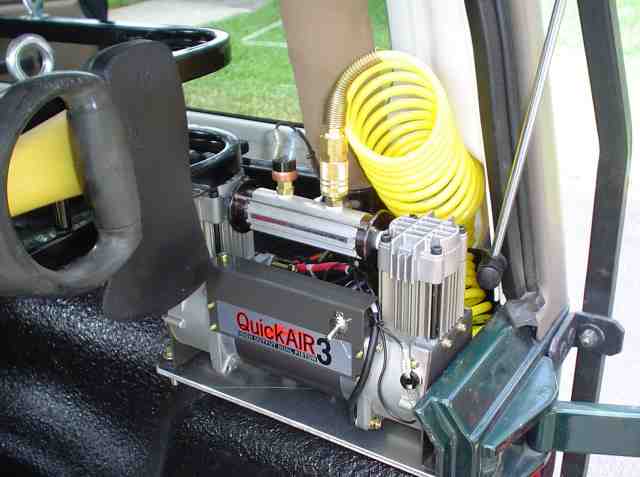
Here is a pic of Bill’s install. As you can see, he mounted the QA3 onto an aluminum plate. Nice clean install and it won’t be sucking up the engine heat all day long before you need to use it to inflate your tires. Thanks Bill for the update information!

